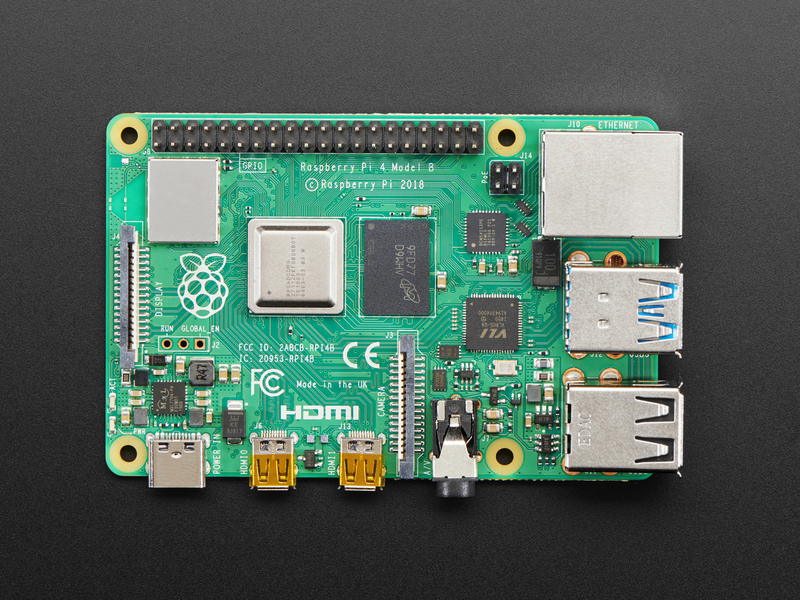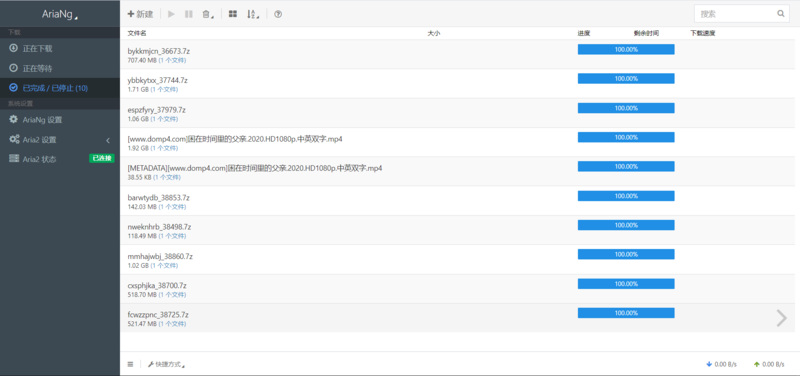之前用 2012 年的老旧笔记本 ThinkPad E530c,做了一个 Aria2 下载服务器。
时间长了发现这玩意耗电还是挺可观的,遂买了树莓派 4B,作为替代。
美其名曰节能减排,实际就是按捺不住骚动的内心,实在是想着折腾点啥吧。

购置
本着能省则省,买了树莓派 4B 的 2G 版本,物品清单如下:
- 树莓派 4B(2G,298 元)
- 电源插头+电源线(媳妇碎屏华为的快充,0 元)
- TF 卡(旧摄像头拆的,32G,0 元)
- 移动硬盘(旧笔记本拆的,1T,挂个硬盘盒,29 元)
- 亚克力外壳+风扇(19 元)
- 散热片(7 元)
- 读卡器(8 元)
- Micro HDMI 转接头(9 元)
总计:350 元整。没算错吧哈哈。
开箱
在公司收到快递,迫不及待的打开包装,上手盘了一会。
散热片还是有必要的。一共五个,撕开胶贴,粘上即可。
外壳+风扇,拧几个螺丝搞定。
在公司还是不敢太嚣张,回家搞。
安装配置
烧录系统
1、下载安装 Raspberry Pi Imager(镜像烧录工具),或其他系统烧录工具。
https://www.raspberrypi.org/software/
2、下载系统镜像,烧录到 TF 卡上,以 Ubuntu Server 为例:
https://cdimage.ubuntu.com/releases/20.04/release/
树莓派是 ARM 架构,切记一定要选择这个版本:
“Raspberry Pi Generic (64-bit ARM) preinstalled server image”
配置 Wifi
如果直接插网线连接路由器,可以略过这一步。
无线 Wifi 需要一些配置,在 TF 卡的“system-boot”分区,修改配置文件“network-config”。
配置文件中可能已经有一些配置项,只不过用井号#注释掉了,可以去掉注释,修改 SSID 和密码。
如下,千万注意缩进,四个空格为一个缩进。
1
2
3
4
5
6
7
| wifis:
wlan0:
dhcp4: true
optional: true
access-points:
"你的无线SSID":
password: "你的无线密码"
|
开机
TF 卡插入树莓派,接入键盘、Micro HDMI 连显示器,插上电源即启动。
正常情况首次启动会慢一些,启动完成后,输入默认的用户名密码:ubuntu/ubuntu,登录。
首次登录会提示修改初始密码,改完记录好。
SSH
现在树莓派还连在显示器上:
查找其中类似于 192.168.1.*或 192.168.0.*的 IP。
当然也可以通过家中的路由器控制界面,来查看 IP。
知道它的 IP,就可以甩开键盘、显示器,自由奔放的 SSH 了:
1
| ssh ubuntu@192.168.1.110
|
Aria2
frp
为了能让 Aria2 在外网访问实现远程下载,这里采用了 frp 端口映射到 VPS 的方式(如果你家里宽带有独立 IP 那更好)。
从以下地址,下载 frp 程序:
https://github.com/fatedier/frp/releases
树莓派 4B 是 arm64 架构,所以需要分别下载 2 个:
frp_0.36.2_linux_arm64.tar.gz
frp_0.36.2_linux_amd64.tar.gz
frps
将 frp_0.36.2_linux_amd64.tar.gz 部署到 VPS 的/usr/local/frps/文件夹。
编辑 frps 配置文件如下:
1
2
3
4
5
6
7
8
9
10
11
12
13
14
15
16
17
| nano /usr/local/frps/frps.ini
[common]
bind_addr = 0.0.0.0
bind_port = 5443
kcp_bind_port = 5443
dashboard_port = 6443
dashboard_user = admin
dashboard_pwd = frps_1024
vhost_http_port = 8080
vhost_https_port = 8443
log_file = /usr/local/frps/frps.log
log_level = info
log_max_days = 3
token = frps的token随后要用
max_pool_count = 50
tcp_mux = true
|
编辑 frps 服务文件如下:
1
2
3
4
5
6
7
8
9
10
11
12
13
14
15
16
17
18
19
20
21
22
23
24
25
26
27
28
29
30
31
32
33
34
35
36
37
38
39
40
41
42
43
44
45
46
47
48
49
50
51
52
53
54
55
56
57
58
59
60
61
62
63
64
65
66
67
68
69
70
71
72
73
74
75
76
77
78
79
80
81
82
83
84
85
86
87
88
89
90
91
92
93
94
95
96
97
98
99
100
101
102
103
104
105
106
107
108
109
110
111
112
113
114
115
116
117
118
119
120
121
122
123
124
125
126
127
128
129
130
131
132
133
134
135
136
137
138
139
140
141
142
143
144
145
146
| #! /bin/bash
PATH=/usr/local/sbin:/usr/local/bin:/sbin:/bin:/usr/sbin:/usr/bin
ProgramName="Frps"
ProgramPath="/usr/local/frps"
NAME=frps
BIN=${ProgramPath}/${NAME}
CONFIGFILE=${ProgramPath}/frps.ini
SCRIPTNAME=/etc/init.d/${NAME}
version="1.1"
program_version=`${BIN} --version`
RET_VAL=0
[ -x ${BIN} ] || exit 0
strLog=""
fun_clangcn()
{
echo ""
echo "+--------------------------------------------------+"
echo "| Manager for ${ProgramName}, Written by Clang |"
echo "+--------------------------------------------------+"
echo "| Intro: http://koolshare.cn/thread-65379-1-1.html |"
echo "+--------------------------------------------------+"
echo ""
}
fun_check_run(){
PID=`ps -ef | grep -v grep | grep -i "${BIN}" | awk '{print $2}'`
if [ ! -z $PID ]; then
return 0
else
return 1
fi
}
fun_load_config(){
if [ ! -r ${CONFIGFILE} ]; then
echo "config file ${CONFIGFILE} not found"
return 1
fi
}
fun_start()
{
if [ "${arg1}" = "start" ]; then
fun_clangcn
fi
if fun_check_run; then
echo "${ProgramName} (pid $PID) already running."
return 0
fi
fun_load_config
echo -n "Starting ${ProgramName}(${program_version})..."
${BIN} -c ${CONFIGFILE} >/dev/null 2>&1 &
sleep 1
if ! fun_check_run; then
echo "start failed"
return 1
fi
echo " done"
echo "${ProgramName} (pid $PID)is running."
return 0
}
fun_stop(){
if [ "${arg1}" = "stop" ] || [ "${arg1}" = "restart" ]; then
fun_clangcn
fi
if fun_check_run; then
echo -n "Stoping ${ProgramName} (pid $PID)... "
kill $PID
if [ "$?" != 0 ] ; then
echo " failed"
return 1
else
echo " done"
fi
else
echo "${ProgramName} is not running."
fi
return 0
}
fun_restart(){
fun_stop
fun_start
}
fun_status(){
PID=`ps -ef | grep -v grep | grep -i "${BIN}" | awk '{print $2}'`
if [ ! -z $PID ]; then
echo "${ProgramName} (pid $PID) is running..."
else
echo "${ProgramName} is stopped"
exit 0
fi
}
checkos(){
if grep -Eqi "CentOS" /etc/issue || grep -Eq "CentOS" /etc/*-release; then
OS=CentOS
elif grep -Eqi "Debian" /etc/issue || grep -Eq "Debian" /etc/*-release; then
OS=Debian
elif grep -Eqi "Ubuntu" /etc/issue || grep -Eq "Ubuntu" /etc/*-release; then
OS=Ubuntu
elif grep -Eqi "Alpine" /etc/issue || grep -Eq "Alpine" /etc/*-release; then
OS=Alpine
else
echo "Not support OS, Please reinstall OS and retry!"
return 1
fi
}
fun_config(){
if [ -s ${CONFIGFILE} ]; then
vi ${CONFIGFILE}
else
echo "${ProgramName} configuration file not found!"
return 1
fi
}
fun_version(){
echo "${ProgramName} version ${program_version}"
return 0
}
fun_help(){
${BIN} --help
return 0
}
arg1=$1
[ -z ${arg1} ]
case "${arg1}" in
start|stop|restart|status|config)
fun_${arg1}
;;
[vV][eE][rR][sS][iI][oO][nN]|-[vV][eE][rR][sS][iI][oO][nN]|--[vV][eE][rR][sS][iI][oO][nN]|-[vV]|--[vV])
fun_version
;;
[Cc]|[Cc][Oo][Nn][Ff]|[Cc][Oo][Nn][Ff][Ii][Gg]|-[Cc]|-[Cc][Oo][Nn][Ff]|-[Cc][Oo][Nn][Ff][Ii][Gg]|--[Cc]|--[Cc][Oo][Nn][Ff]|--[Cc][Oo][Nn][Ff][Ii][Gg])
fun_config
;;
[Hh]|[Hh][Ee][Ll][Pp]|-[Hh]|-[Hh][Ee][Ll][Pp]|--[Hh]|--[Hh][Ee][Ll][Pp])
fun_help
;;
*)
fun_clangcn
echo "Usage: $SCRIPTNAME {start|stop|restart|status|config|version}"
RET_VAL=1
;;
esac
exit $RET_VAL
|
最后刷新一下服务:
1
2
3
| systemctl daemon-reload
systemctl start frps
systemctl status frps
|
frpc
将 frp_0.36.2_linux_arm64.tar.gz 部署到树莓派的/usr/local/frpc/文件夹。
编辑 frpc 配置文件如下:
1
| nano /usr/local/frpc/frpc.ini
|
1
2
3
4
5
6
7
8
9
10
11
| [common]
server_addr = VPS的IP地址
server_port = 5443
authentication_method = token
token = VPS上frps的token
[aria2]
type = tcp
local_ip=127.0.0.1
local_port = 6800
remote_port = 8600
|
编辑 frpc 服务文件如下:
1
2
3
4
5
6
7
8
9
10
11
12
13
14
| [Unit]
Description=FRP Client Daemon
After=network.target
Wants=network.target
[Service]
Type=simple
ExecStart=/usr/local/frpc/frpc -c /usr/local/frpc/frpc.ini
Restart=always
RestartSec=20s
LimitNOFILE=infinity
[Install]
WantedBy=multi-user.target
|
最后刷新一下服务,启动服务,查看服务状态是否正常
1
2
3
| systemctl daemon-reload
systemctl start frpc
systemctl status frpc
|
部署 aria2
强烈推荐使用 P3TERX 的 aria2.sh 脚本来安装 aria2,非常简单:
https://github.com/P3TERX/aria2.sh
1
2
3
| apt install wget curl ca-certificates
wget -N git.io/aria2.sh && chmod +x aria2.sh
./aria2.sh
|
后续步骤按提示操作即可,最后成功了,会有如下输出:
1
2
3
4
5
6
7
8
| Aria2 简单配置信息:
IPv4 地址 : 123.123.123.123
IPv6 地址 : IPv6 地址检测失败
RPC 端口 : 6800
RPC 密钥 : Aria2_1024
下载目录 : /share/downloads
AriaNg 链接 : http://ariang.js.org/#!/settings/rpc/set/ws/123.123.123.123/6800/jsonrpc/token
|
将最后一行地址中的“123.123.123.123”换成 VPS 的 IP 地址,即可远程访问 Aria2。

网络链路如下:
浏览器 -> ariang.js.org 提供的 AriaNg 前端 -> VPS 的 frps 转发 -> 树莓派的 frpc 接收 -> aria2 程序交互
部署 AriaNg
也可以不用 ariang.js.org 的前端,自己部署一个 AriaNg。
从 Github 下载 AriaNg(AllInOne 是单个 html 文件),部署到 VPS 的 Nginx 或 Apache 即可:
https://github.com/mayswind/AriaNg/releases


v1.4.14